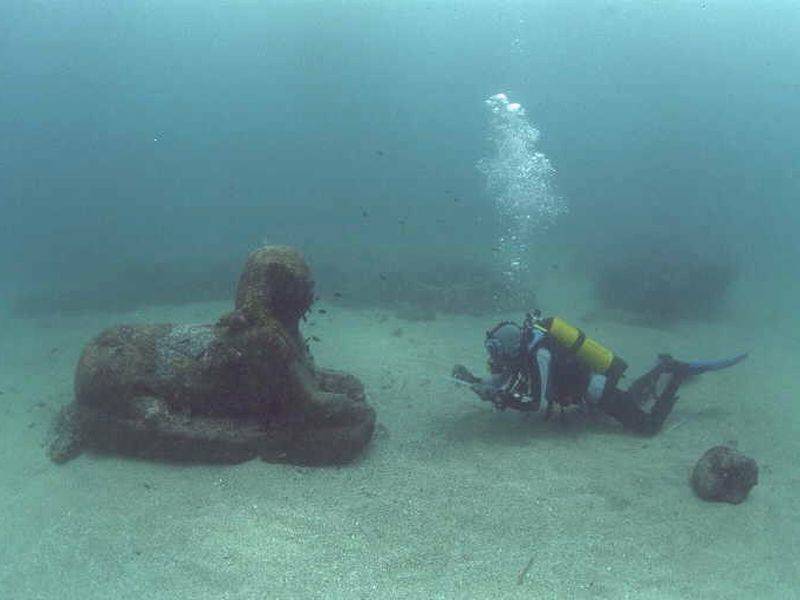The lighthouse of Alexandria is one of the seven wonders of the ancient world, the most recent. It is a tall lighthouse made of stone, with characteristic architecture and whose remains are currently in the port of Alexandria. The importance of this edifice placed it on the list of the seven wonders even though it did not appear in it intially: The document which serves us as a reference, the Palatinus 398, written by Philo de Bysance, not mentioned simply because it was earlier, but the lighthouse came to replace the ramparts of Babylon from this list at a time we do not know.
The presence of the Alexandrian pahre among the seven wonders of the world is thus a way of marking the power of the Egyptian kingdom during Antiquity, Alexandria being the commercial, social and intellectual center of this kingdom at that time. Constructed during the 3rd century BC, it was demolished definitively during the 14th century, when the region underwent major earthquakes.
Before the construction of the lighthouse
The context
Nowadays Alexandria is Egypt's second largest city by population, and it is a coastal city of great importance, the country's gateway to the sea. But already in the 3rd century BC the city was a center of knowledge, in the sense that the world of the time was limited to the Mediterranean and the surrounding kingdoms. The most popular areas were literature, science, mathematics, astronomy and medicine. Many scholars make discoveries that we always remember or that are still used. On the architectural side, it is essentially the monuments that are remarkable. The city is covered with edifice whose purpose is to mark the power of the kingdom. These monuments are built over time, at different times.
By the end of the third century BC the population had increased considerably. The port before a strong activity, it is around him that will build the famous lighthouse.
Learn more about the Context of the lighthouse of Alexandria .
The reasons for the construction of the Alexandria lighthouse
There are two reasons for the construction of the Alexandria lighthouse. First of all a utilitarian reason. The city had, at a short distance, an island called "Pharos". Gradually brought closer to the land by the deposit of silt brought by the Nile, it became a peninsula, forming two curves tightening towards the earth, delimiting two natural harbors that were quickly used.
Still, the Egyptian coast is dangerous. Flanked by reefs flush with the surface and even under water, it has sent a large number of Greek and Roman ships to the bottom, causing human dramas and material losses. To secure the port it was necessary to build a lighthouse, which was done.
The other reason is symbolic. A lighthouse was a rare building in the world, it was difficult to build because the proximity to the sea made complex work and the maintenance of the building was much more difficult to achieve than for buildings on land. Moreover, such works were always more useful for other buildings than for a lighthouse, which had always been used by sailors. It was therefore not only useful to build a lighthouse at the entrance to the port. It also marked the power of Egypt, and more particularly of Alexandria. The lighthouse was therefore a symbol of power, it served to propagate the name of Alexandria in the World.
Note that its reputation was so great that the name of this island became a common name: The island of Pharos, originally the word "Pharus" in Latin, which became "Phare" in French. All the Latin languages have the same word to designate this edifice.
Lighthouses before the 3rd century
Of course the lighthouse of Alexandria was not the first in history, but if one retains this one it is for its imposing silhouette and immense size that one rendered without comparison with those that existed before.
The Mediterranean is not particularly rich in lighthouse before the 3rd century, but the Greeks used to build it at the entrance of certain ports. They were fired on fire all day and especially at night. One of the oldest is that of Phanari, from the 6th century BC. Of modest size (2m54), it consists of a cylindrical tower of 3m50 in diameter at the top of which were placed slabs of sandstone on which the appointed persons kept the fire alive. In Piraeus, the port of Athens, there are several vestiges of lighthouses, the oldest of which date from the 5th century BC. On the island of Thasos, in the Aegean Sea, there is also a lighthouse dating from the 6th century BC. All this proves that if the idea of directing ships to the port via lighthouses is not new, that of building a large lighthouse is, and that is the reason for the magnificence of that of Alexandria .
The Works
Who is the architect of the Lighthouse of Alexandria?
This is a question that is difficult to answer because the sources are scarce and inaccurate. This monument has long been attributed to Sostratos of Cnidus. He was a powerful man, who had the ears of kings, a close relation to King Ptolemy I and his son. Its name was found on the monument, written in lead characters, as indicated in ancient documents by the Greek geographer Strabo and Lucien, and it was this mention that made all the specialists the origin of the lighthouse. But nowadays this thesis is refuted because such a monument could not have received other mentions than that of King Ptolemy I, which he surely received but of which we have no trace. In fact, a papyrus preserved in the Louvres tells us that the dedication was not intended for the lighthouse but for the statue that overcame it. It is a poem.
This safeguard of the Greeks, that watchman of Pharos, O Lord Proteus, has erected him, son of Dexiphanes of Cnidus, for in Egypt you do not look for heights on islands; at the level of the water stretches the bay where the boats anchor. That is why erect upright, cut out the sky a visible tower at innumerable stages during the day. At night, in the midst of the waves, the sailor will see the great fire which, at the top, burns, and can run straight on the horn of the Tauros, and which navigates in these waters, can not fail, O Proteus, Zeus Savior.
Besides, Sôtratos de Cnide was an ambassador and was a very rich person, one can even imagine that he was the financier of the lighthouse and not his architect. One can tend towards this hypothesis by reading the poet Poseidippos who lived at the time of the construction of the lighthouse and who speaks of Sôstratos like the one who erected the lighthouse but also of Strabo, the Greek geographer, who uses the words "he dedicated "and not" he built ". The first traces of Sôstratos as an architect date from the 1st century AD, in Book XXVI of "Natural History", Pliny the Elder. Is this the beginning of an error that will endure to the present day or the reality? For the time being neither the archaeologists nor the historians have succeeded in answering this question clearly.
Note that Cnide was a ruined city on the Turkish coast, facing the island of Rhodes.
Lighthouse of Alexandria
If the architect of the lighthouse remains unknown to this day, the place of edification is perfectly known, it is on the island of Pharos, an island which at the time was a short distance from the coast. Since the silts of the Nile have filled the arm of the sea between the two, turning the island into peninsula. The lighthouse was at the eastern end of the island, on the site of Fort Qaitbay. Moreover, the latter was built partially with the stones of the collapsed lighthouse.
This island was at that time more important than it is today. It was higher, roughly 5 to 6 meters, and it had support walls that are always visible in scuba diving. Proof of the location of the Alexandria Lighthouse was provided by teams of French archaeologists who carried out a series of underwater diving in the harbor, as explained below. It should also be noted that Diamond Island was mentioned as a possible place to build the lighthouse, but this hypothesis is now obsolete. In any case, this island is too frightening for it to have received a lighthouse, even after the bombing of 1882 that it received from the English navy.
Larn more about the location of the wonders.
Duration and cost of work
It is the Souda, a Greek text of the Xth century, which makes it possible to know the date of the beginning of the work, 297. A translation of this text, for Article 113 of the letter Phi, is :
Lighthouse: to the masculine, designates the Lighthouse of Alexandria, that erected under Ptolemy king of Egypt Sostrate of Cnidus, son of Dexiphanes, on Pharos, the island of Proteus, at the time when Pyrrhus the heir Achilles has already received power over Epirus.
This provision being given to him in 297, we have here the date of beginning of the works. They would have lasted only 15 years if one believes the chronology of Eusebius which affirms that it was completed at the time of the 124th Olympiad, under Ptolemy II. It places work between the reigns of Ptolemy I and Ptolemy II, from 297 to 283 BC.
Such a speed in the construction of such a building is quite remarkable, it is a sign both of a good knowledge of the architecture, but also of the financial health of the sponsor, the satrap (governor) of Egypt became king Ptolemy I, who could put the means to finish his monument quickly. At that time it was common to see construction sites stretching for several generations, even if they were not the most frequent cases.
As far as the cost of the lighthouse is concerned, it is estimated by Pliny the Elder to 800 talents of silver (Pliny the Elder lived in the 1st century AD, 4 centuries later). Difficult to make an effective comparison with modern means ...
Equipment
The lighthouse of Alexandria was built of limestone from a quarry near the coast. Geologically this area is sufficiently rich in stone to have necessitated the transport of stones from other regions, unless they have explicitly wanted special stones. It could have been the case, such as using marble, but in practice it is indeed limestone that was used. These stones had a clear appearance, which made the visitors say that the lighthouse was white - which is false. Note that the stones of Fort Qaitbay are reusable from those of the lighthouse, so have little to see nowadays what these stones were at the time. Moreover, those found in the port are indeed limestone. But limestone is a soft stone, for a lighthouse it is not a very suitable material. It is easy to imagine that in the 3rd century BC it was difficult to recover more solid stones in other regions, but this is what was done for the part of the lighthouse most at risk: Angles of the building, frames of the doors and windows, which were built of granite from Aswan. One finds such a way of building at Fort Qaitbay.
The fitting of the stones is quite surprising, as far as we know. The description of the assembly of the lighthouse is little known, it is a hypothesis. The manufacturers obviously did not use mortar to tie the stones together but used an old grooving technique. They were visibly assembled on a bed of molten lead, acting as a shock absorber. What is factual is that the rate of lead in the sea around the archaeological site is important, according to Jean-Yves Empereur, the French archaeologist in charge of maritime excavations.
Description
What was the lighthouse like?
In fact it is easy enough to know what the lighthouse of Alexandria looked like, as it is represented many times on ancient documents. Ancient, but not enough to be contemporary with the monument, so there is always a part of interpretation in its representation, however weak. But to be honest, the lighthouse of Alexandria is probably the wonder of the World that is best known, aesthetically speaking, apart from the Pyramid of Cheops, of course.
Let us begin with descriptions of witnesses.
In 1154 a certain Edrisi made a description of the lighthouse of Alexandria.
One notices the famous lighthouse which has no equivalent in the world in terms of structure and solidity; for, independently of what is made of excellent stones of the kind called caddzan, the foundations of these stones are sealed together with molten lead, and the joints are so adherent that the whole is indissoluble, that the waves of the sea, on the north side, continually strike this edifice. They ascend by a broad staircase, built in the interior, as are ordinarily those which are practiced in the towers of the mosques. The first staircase ends towards the middle of the lighthouse, and there the edifice becomes narrower by its four sides. In the interior and under the staircase were built rooms. Starting from the middle gallery, the lighthouse rises to its summit, narrowing more and more, not beyond, however, that a man can always make the turn while ascending. From this same gallery one ascends again, to reach the summit, by a staircase of dimensions narrower than those of the lower staircase. The lighthouse is pierced, in all its parts, with windows destined to procure daylight for persons ascending, and so that they may properly place their feet in ascending. This edifice is singularly remarkable, on account of its height as well as its solidity; it is very useful in that it lights night and day of fire to serve as a signal to navigators; the people of the ships recognize this fire and are directed accordingly, for it is visible from a maritime day [100 miles] away. During the night, it appears as a brilliant star; during the day one distinguishes the smoke.
Shortly before, in 1117, Al-Andalusi, went to Alexandria and made another description.
The entrance to the Lighthouse is very high. It is accessed by a long 183-meter ramp. This is based on a series of arches [...]. Once we reached the top of the first floor, we measured its height above the ground with a piece of rope to which we attached a stone. We found 57.73 meters [...]. In the center of the terrace of this first floor, the building was prolonged, but with an octagonal shape [...]. This second floor was higher than the first. On entering we saw a staircase which consisted of eighteen steps, and we debouched in the center of the second terrace. The building was still prolonged in a cylindrical form [...]. We entered and ascended thirty-one steps to reach the third floor, the height of which we measured with our rope: 7.32 meters. On the terrace of this third floor, there was a mosque with four doors and a dome.
Learn more about Dimensions of the lighthouse.
Architecture of the lighthouse of Alexandria
The lighthouse of Alexandria is a monolithic building that measured 135m high. It was on 3 floors: On the ground, a heavy square building, on which was built another octagonal building. At the top, the third floor was cylindrical. This form with three levels is found in other lighthouses of the Greek Empire, that of Taposiris Magna is an example. The access door was fairly high in relation to the ground, so the lighthouse had an access ramp on the first floor, a ramp which was mounted on sixteen impressive arches. This idea of putting the door up was not an originality, the first buildings to have it were essentially defensive, it made it possible to secure access to the door by removing the ladder, for example. But here it was useless to defend access to the lighthouse, the ramp was therefore hard, not removable.
The first floor was built on a platform about ten meters high, it was pyramidal and square. The building itself was hollow and contained an access ramp on the second floor and about fifty rooms, so it was a real urban complex, not at all a simple block of solid retaining stone. These various rooms were used for the service of the lighthouse. There were rooms for the staff who kept the fire at the top, others for storing wood for its food. The ramp was wide and allowed the passage of oxen to carry the wood towards the top of the lighthouse, it was illuminated by a series of windows, small and long, arranged along the ramp and thus, outwardly offset compared to others. To get a good idea of what was the first floor of the lighthouse it is enough to observe the temple of Osiris, near Alexandria: Built by Ptolemy II, so contemporary, it shows exactly the same structure massive exterior and hollow interior, with many rooms and an internal staircase. This part of the lighthouse was 71m high and at its summit was a terrace equipped with a high railing of 2,30m and carved Tritons blowing in horns, a means of preventing accidents at sea.
The second floor was 34m high, about half the first. It was octagonal in shape and as for the first floor it was hollow, but unlike it it was equipped with an internal staircase, not a ramp. It must be said that at this level the lighthouse was too narrow to make a ramp, so it was at the top of the first floor that the beasts of burden climbed the wood to burn at the top, for the rest of the trip, it had to be done by hand.
The third floor was the lowest, only 9m. It had a cylindrical shape and was equipped with an internal staircase.
The statue of the summit
At the top of the lighthouse there was a statue of Zeus, it is known that it was installed there during the first half of the third century BC. But the different representations of this statue through time leaves a doubt about its replacement during the following centuries. An object found in Asia Minor and representing the lighthouse shows us a statue with a boat oar, which would identify it with Poseidon, the Roman God. It could be credible for two reasons.
- The island of Pharos welcomed a temple to the glory of Poseidon on the western part,
- Egypt was a Roman province.
If it is true that ancient history tells us that Egypt was a province of the Roman Empire, it is not unusual to find a Roman God at the top of the most emblematic tower of Alexandria. But this proposition is not really valid, as the Romans only conquered Egypt three centuries later (30 years BC).
What is more, we find an intaglio (hard stone engraved in hollow) of the first century AD which shows Zeus on the lighthouse, proof that the statue would have remained in its place during 4 centuries. How to be sure of the chronology of the statues set up at this summit? Difficult because the Roman Empire having banished all pagan representations from 391, but in 539 a witness assures that there was a statue of Helios at the top of the lighthouse. Yet the Roman Empire was already Christian, and it seems normal that at this site a statue of Christ should have been implanted.
Note however that there were other statues on the lighthouse, along its base. Some have been found recently, they have been taken out of the waters of the port. One of them would be Queen Berenice represented in Isis with her husband represented in Pharaoh. Isis was a glorified goddess on the island of Pharos, as was Poseidon.
Operation
Little information has been received on the operation of the lighthouse, but there is not much to discover, obviously. The fire was lit on the highest part, the one on which there was the statue. It was important, visibly powerful, and it was maintained day and night. In the daytime, it was the smoke which directed the boats, at night it was the brilliance. It appears that the lighthouse of Alexandria was visible to 50Kms in the round.
In order to feed it, a large quantity of wood had to be stored in the first floor of the tower. A ramp, as indicated in the description, was the inner circle. Oxen were able to circulate there, stepping the trunks regularly for storage. The suite had to be done manually, the stairs becoming too narrow for the beasts of burden. In the course of time it is possible to switch to other fuels, especially oil.
Some sources indicate that the lighthouse was equipped with reflective mirrors to increase its visibility, it seems to be false. In any case, it is not credible, in the current state of knowledge.
Evolution of the lighthouse in time, its degradation
It is difficult to follow the lighthouse in time, because the testimonies of this period are missing. It is known that the Emperor Anastasius I (491-518) had renovations of the submerged subsoil to a certain Ammonios. In 670 the French bishop Aroulfe explains in a document the role of the tower of Pharus, its operation, and the reason why it is important to enter safely in the port. He takes the opportunity to point out that the island is surrounded by pious massifs intended to support the banks.
The lighthouse of Alexandria, built at one time, has obviously not undergone any major changes during its existence. In fact, the modifications were essentially natural. It was an earthquake that destroyed the third floor of the lighthouse during the tenth century. Lying on the ground, the summit was never rebuilt. In his place the sultan Ahmed Ibn Tulun, who ruled the city, had an oratory built, giving the lighthouse a mosque role (and in the process, it was the highest mosque in the world). If you observe the minaret that this sultan built in Cairo, you will find that it follows the same architectural form as the lighthouse of Alexandria: Square at the bottom, octagonal at the center and cylindrical at the top.
In 1303 a second earthquake struck him again, more violently. If one believes a writing preserved in Montpellier (Cartular of Montpellier), the exact date of the shake is the 8 of August.
In the year 1303, on the 8th of August, there was a great earthquake in Alexandria, which caused the lighthouse to fall, and the third part of the town to fall.
But the destruction does not seem to have been complete since Ibn Battuta was still able to describe the lighthouse in April 1349.
Having gone to the Lighthouse on my return from the Maghrib in the year 750, I observed that its state of disrepair was such that it was no longer possible to enter it, nor to reach the door giving access to it.
It was only at the end of the 15th century that the lighthouse of Alexandria, or rather what remained of it, was completely dismantled. The stones were then used for the construction of Fort Qaitbay, which guards the entrance of the port of the city still today.
If there are not enough texts explaining how the lighthouse was built and how it went through the centuries, we still have some information thanks to interesting testimonials.
As stated above In 670 the French bishop Aroulfe made a description of the site, it is very old. In 870 it was an official in Egypt, a Bagdadi, who made another similar description. The lighthouse was then always used daily.
Ali al-Mas'udi, who was born in Baghdad and died in Cairo around 956, was an Arab historian and geographer. Witness to the slow disappearance of Alexandria due to the various seismic shocks as well as to the subsidence of ground, it describes precisely the damages caused. His narrative gives details of the state of the lighthouse, which is already partly in ruins.
The testimony of Abu al-Haggag Yusuf Ibn Muhammad al-Balawi al-Andalusi is interesting because it dates from the twelfth century, so it is done shortly before the severe destruction of the lighthouse (1303) and sufficiently late to be us without too much deformation. He describes the access ramp, the high door, the general shape of the lighthouse. In the fourteenth century it was Ibn Battuta who took up a similar description, two centuries later.
Learn more about History of the lighthouse.
Permanent disappearance of the lighthouse
Why did the lighthouse of Alexandria disappear? In fact it's quite simple, it has undergone two events. First of all it was abandoned and without maintenance, it is found in the 10th century heavily degraded after an earthquake dropped the 3rd floor. He could no longer serve at that time, and it was a long time ago that he was no longer serving. The lighthouse could have been repaired and consolidated but the Arab civilization of the early Muslim times did not have the magnitude of the previous civilization, so it was impossible for them to correct it. This period lasted until the end of the fifteenth century, when it was so degraded that it was demolished. The stones were recovered and used for the construction of the Qaitbay which guards the entrance of the port of the city still today. So it was at the end of the 15th century that we lost all hope of reviving the lighthouse of Alexandria.
In the port of Alexandria there are vestiges of the lighthouse, the stones that had been damaged in the sea without being able to easily ascend them. Diverse archaeologists work regularly on this site.
Underwater archeology
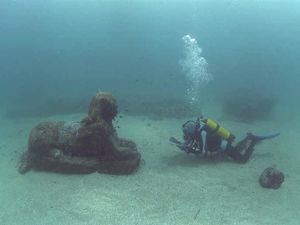
Excavation
For a long time it has been known that vestiges of the lighthouse must be immersed at the bottom of the port of Alexandria, but it was not until the modern period that we thought of making real archaeological explorations.
The first underwater excavations took place in 1968, but they were quickly stopped. They resumed between 1992 and 1998 under the responsibility of a Frenchman, Jean-Yves Empereur, and through the Center d'Etudes Alexandrines. These explorations made it possible to identify many submerged blocks as well as various statues that were brought up to the surface, in particular a Ptolemy I in Pharaoh and Isis.
Learn more about the underwater exclavations.
Representation of the lighthouse
Of the seven wonders of the ancient world, the lighthouse of Alexandria is probably the one with the most written traces - except for the pyramid of Cheops, of course. But in Alexandria, his memory is even more vivid. The city has a logo that represents it, of course, as well as the University of the city.
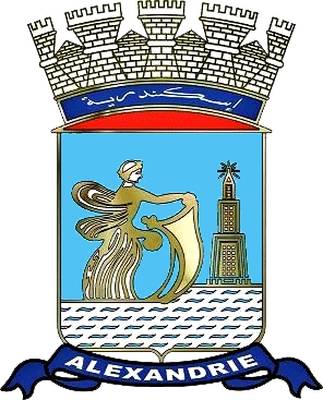
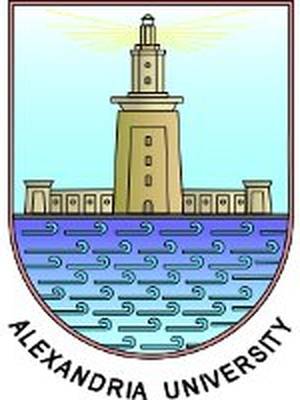
Such modern representations are interesting because they show the attachment of the Alexandrians to their heritage, even disappeared, but nothing will be worth the interest of the representations of time on various supports, in the course of time. And first of all, representations which were made during the life of the monument, that is to say between the third century BC and 1303, for even if after that date it was still there, it was ruined and no had then no more interest, waiting only to be dismantled definitively..
IIe siècle
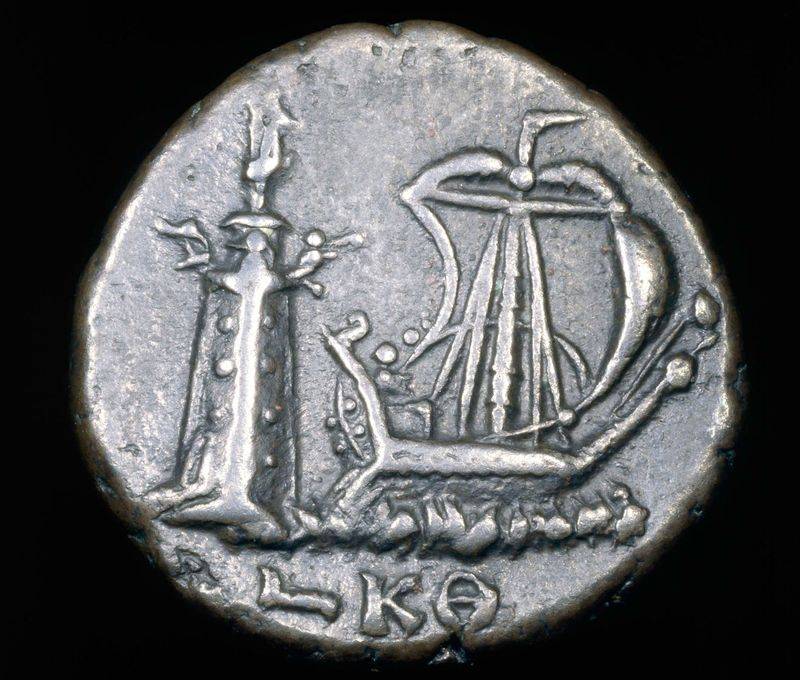
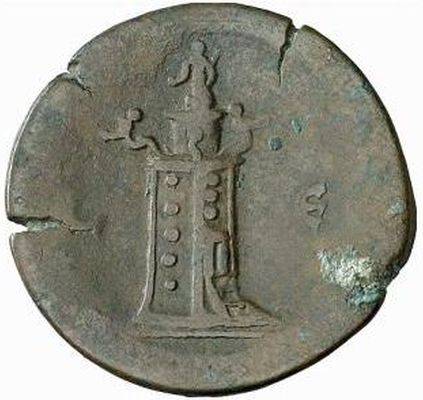
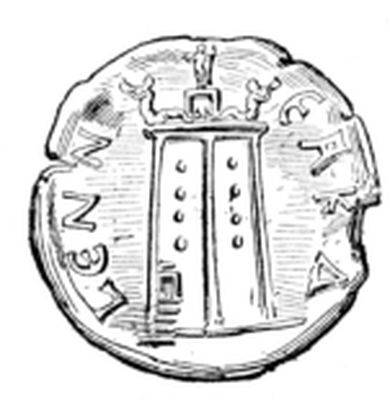
These pieces are presented from the most recent to the oldest. They are part of the oldest representations of the lighthouse of Alexandria and although the image is not precise, we guess the general form. Two of these pieces, struck 400 years after the construction of the lighthouse, emphasize the statues of the peaks.
Left: A coin dating from the Emperor Commodus (180-192). It represents the lighthouse of Alexandria and a boat passing nearby. (Bibliothèque nationale de France, Department of Mint)
In the center: A coin dating from Emperor Antonin (138-161). It represents the lighthouse of Alexandria (Private collection)
Right: A coin dating from Emperor Hadrian (117-138). It represents the lighthouse of Alexandria (Private collection)
VIe century
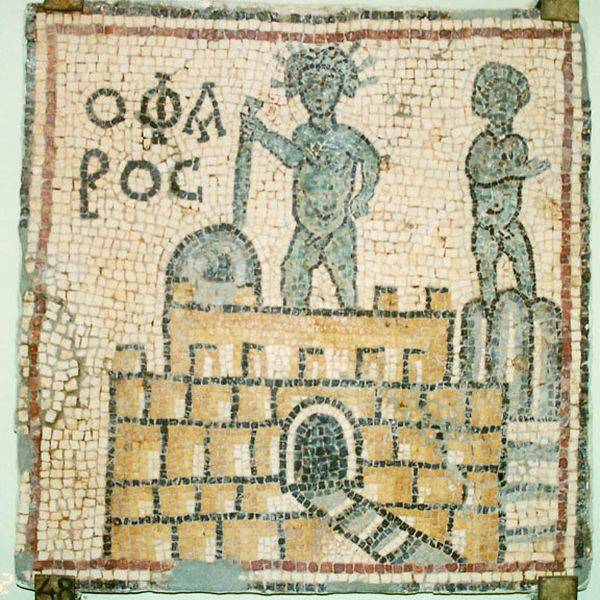
This mosaic dates from 539 AD to the Museum of Qsar, in Libya. It represents the lighthouse of Alexandria with the statue of Zeus at its summit. It can be confused with Helios since it carries a belt of solar rays around the head, as does the God of the Sun (a symbol taken from the Statue of Liberty centuries later.
XIIe century
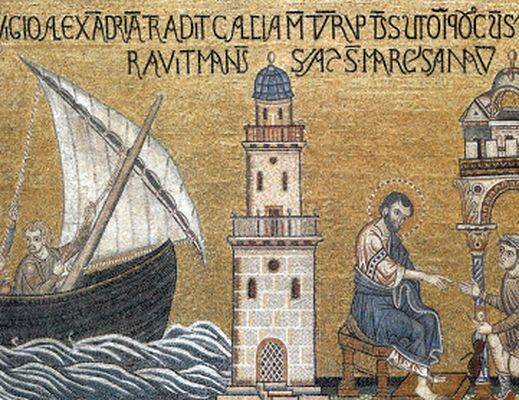
One of the last representations of the lighthouse before its destruction is in Venice, on a mosaic of the Basilica of St. Mark. Finding it is not so simple so this basilica is rich mosaic issue. This representation is therefore fairly faithful. Even if the difference between the square part and the cylindrical part is not distinguished on such work, it seems that the proportions are correct. There is a beginning of ramp access, and each floor is protected by a sort of backstay. The summit conforms to past descriptions but it does not remind the presence of a statue at its summit. Also it seems that the windows are not properly arranged, the lighthouse seemingly had windows in ququito.
The representations subsequent to 1303 lack credibility because they were made from memories (for the most reliable) or are purely imaginary (in the worst case). Between the two there was room for some images that were based on information not totally false.
The representations subsequent to 1303 lack credibility because they were made from memories (for the most reliable) or are purely imaginary (in the worst case). Between the two there was room for some images that were based on information not totally false.
XVIe century
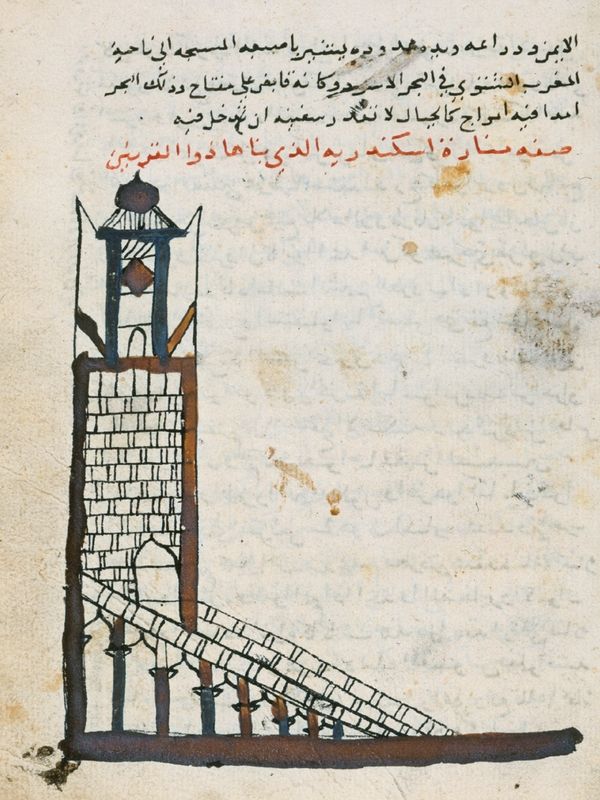
This drawing dates from the 16th century, it was realized by Muhammad al-Qaysi al-Gharnatî. It is currently in a book kept at the Bibliothèque Nationale de France. This is a very simple drawing that does not compete with those made at the same time by Western artists. This one has the merit of existing, it shows a lighthouse without the octagonal central part and emphasizes the ramp of access.
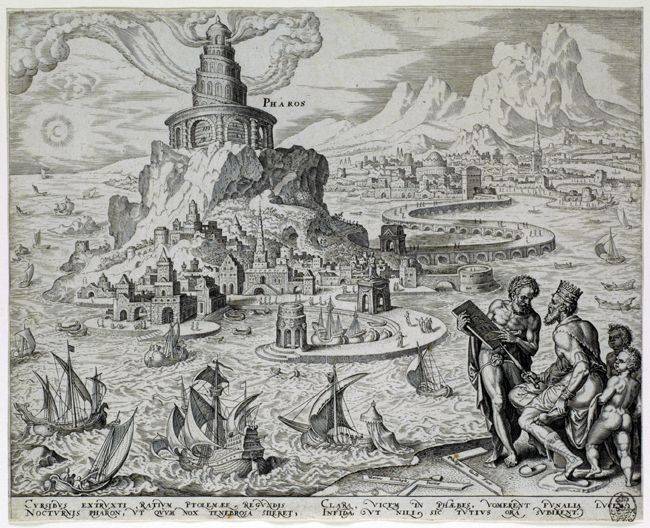
Maarten van Heemskerck was a portraitist and historical painter of the course of the Netherlands. One of these works consisted in drawing the seven wonders of the world, of which the reproduction of the lighthouse of Alexandria is given here.
It shows a colossal work, but above all a work of fiction because this representation is probably the furthest from what could have been drawn from all time. The headlight, cylindrical and low, has a strange helical ramp. It is on an island built and with a winding road in the sea, whereas reality, on this not so distant point, would have shown a straight road. The background is covered with mountains whereas there are none in Alexandria. Without the mention "Pharos" one could have a doubt about what this monument, in the first surroundings.
See then 7 wonders of the world by Maarten van Heemskerck.
XVIIIe century
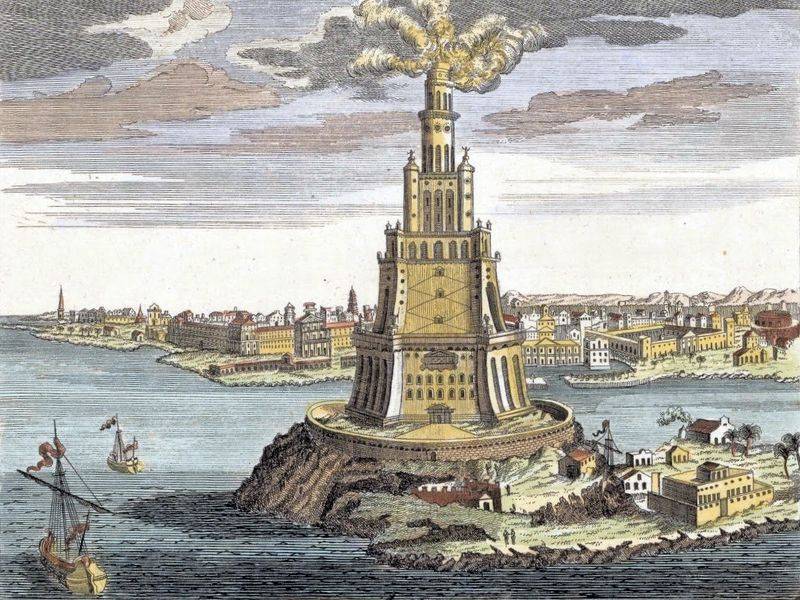
This image, well known in the archeology world of the lighthouse of Alexandria, is a pure invention based on real elements. But one in the other, it is very far from the truth, with a tower with 4 levels instead of 3, a circular ramparts and curious decorations on the walls that reality ignores. The very form of the island is a heresy, the island of Pharos being rather long whereas this representation designates it as circular.
His author is Johann Bernhard Fischer von Erlach, he was an architect and sculptor. Austrian notionality (Graz, July 20, 1656 - Vienna, April 5, 1723, is the origin of the Austrian late Baroque architectural style, which is confirmed in this drawing where one can feel the influence of the baroque.
The lighthouse as a model
The lighthouse of Alexandria has always been a model for maritime activity around the Mediterranean. It can be found in several similar forms in various countries such as Egypt, Libya, Algeria, but also in France, Italy, Spain and even in Great Britain where the shape of the Dover lighthouse, built at the Roman period, was inspired by that of Alexandria.
Most of these lighthouses have disappeared nowadays, and those that are still in place are either still in use, and in this case they have been modernized to the point where they no longer find antique or abandoned, and in this case the remains are sometimes in good condition, but most of the time they are strongly overhauled over time.
Learn more about the copies and replicas of the lighthouse of Alexandria.





